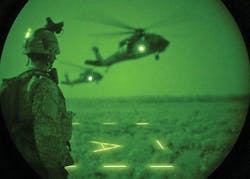Electro-optical sensor designers shrinking infrared pixel size to enhance image resolution
Smaller pixel size not only means better infrared image resolution, but also longer range and potentially smaller size and weight because of reduced need for sensor cooling, says Philippe Bensussan, the SOFRADIR chairman and CEO.
Bensussan made his comments this week in an interview at the SPIE Defense and Commercial Sensing conference in Baltimore.
Infrared sensors are important imaging sources on platforms ranging from orbiting satellites to soldier rifle sights, and everything in-between. They play key roles in applications like military night vision, structure fire detection, missile guidance, and drivers enhanced vision systems.
Infrared sensors in the most demanding applications -- which require high-resolution imagery, long ranges, or both -- typically use cooling. Long-wave infrared in particular relies on detecting the differences between temperatures of objects in its field of view. Cooling heightens that ability.
Cooling, however, introduces extra system size, weight, power consumption, and cost. Only those applications that absolutely require it use cooling.
Now what happens when pixel size gets smaller? Obviously resolution gets better, but other system design issues also come into play. Enhanced resolution could enable designers to build smaller infrared sensors for use in rifle sights, handheld sensors, body-worn detectors, or other small-form-factor uses.
Smaller infrared sensors also lend themselves to a wider variety of unmanned vehicles. Some of the smallest hand-launched unmanned aerial vehicles (UAVs), for example, could be outfitted with imaging sensors -- even multispectral imaging sensors. It could be a big advantage in the war against improvised explosive devices (IEDs), for example.
Smaller pixel size also offers the potential to use several sensors in a system instead of just one. This can enable new capabilities like wide-field-of-view surveillance that stitch together imagery from more than one sensor.
Enhanced resolution also has the potential to reduce system power consumption, which has a direct influence on battery-powered systems. Less power means fewer batteries, which is good news for any infantry warfighter who has to go on patrol with a heavy load.
Related: Sofradir acquires infrared detector technology facilities from Sagem and Thales
Think again about cooling. Enhanced sensor resolution also could reduce or eliminate the need for sensor cooling. That reduces system complexity, cost, size, weight, and cost. It also enhanced reliability. Those all are big advantages to military leaders concerned with tight budgets and overburdened warfighters.
As the transition from 17-micron to 12-micron pixels in infrared sensors, SOFRADIR's Bensussan says his company is in the research and development stage now, with prototype systems in test and demonstration. The company will take this technology to market sometime next year, he says.
For more information contact SOFRADIR online at www.sofradir.com, or the SPIE Defense and Commercial Sensing conference at http://spie.org/conferences-and-exhibitions/defense--commercial-sensing.
